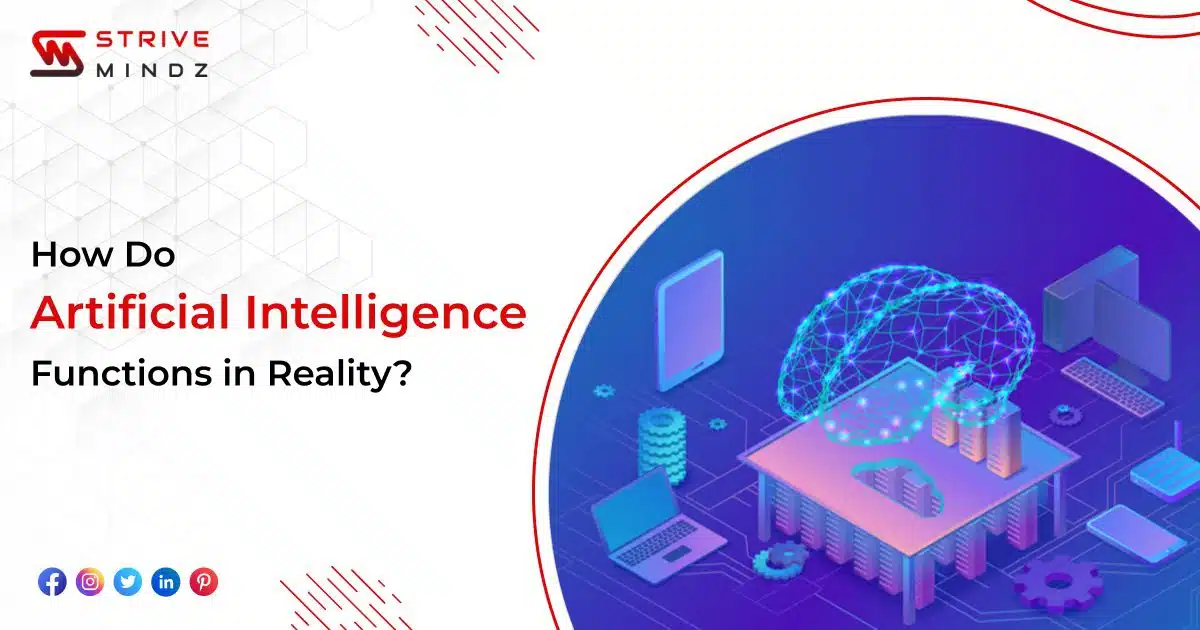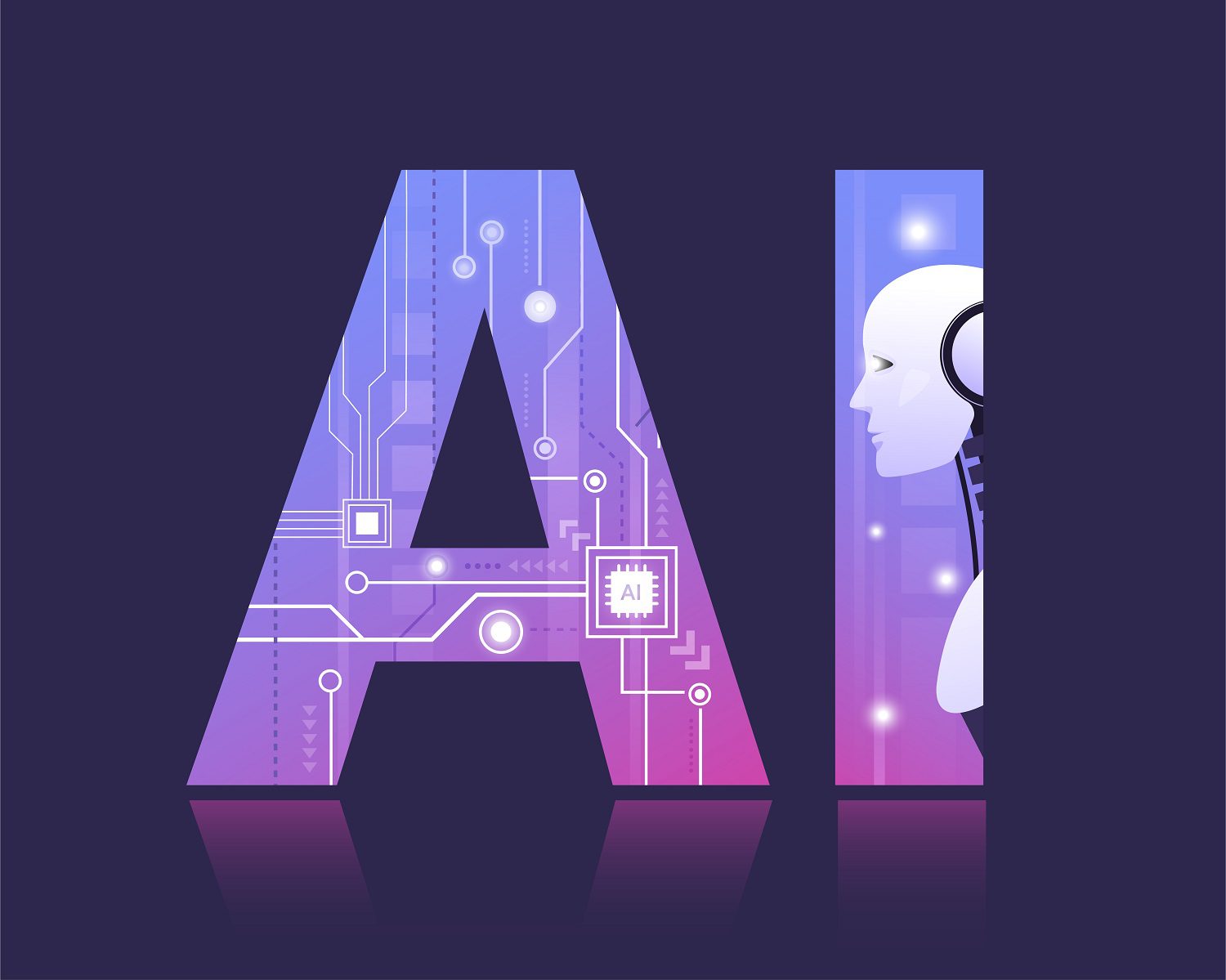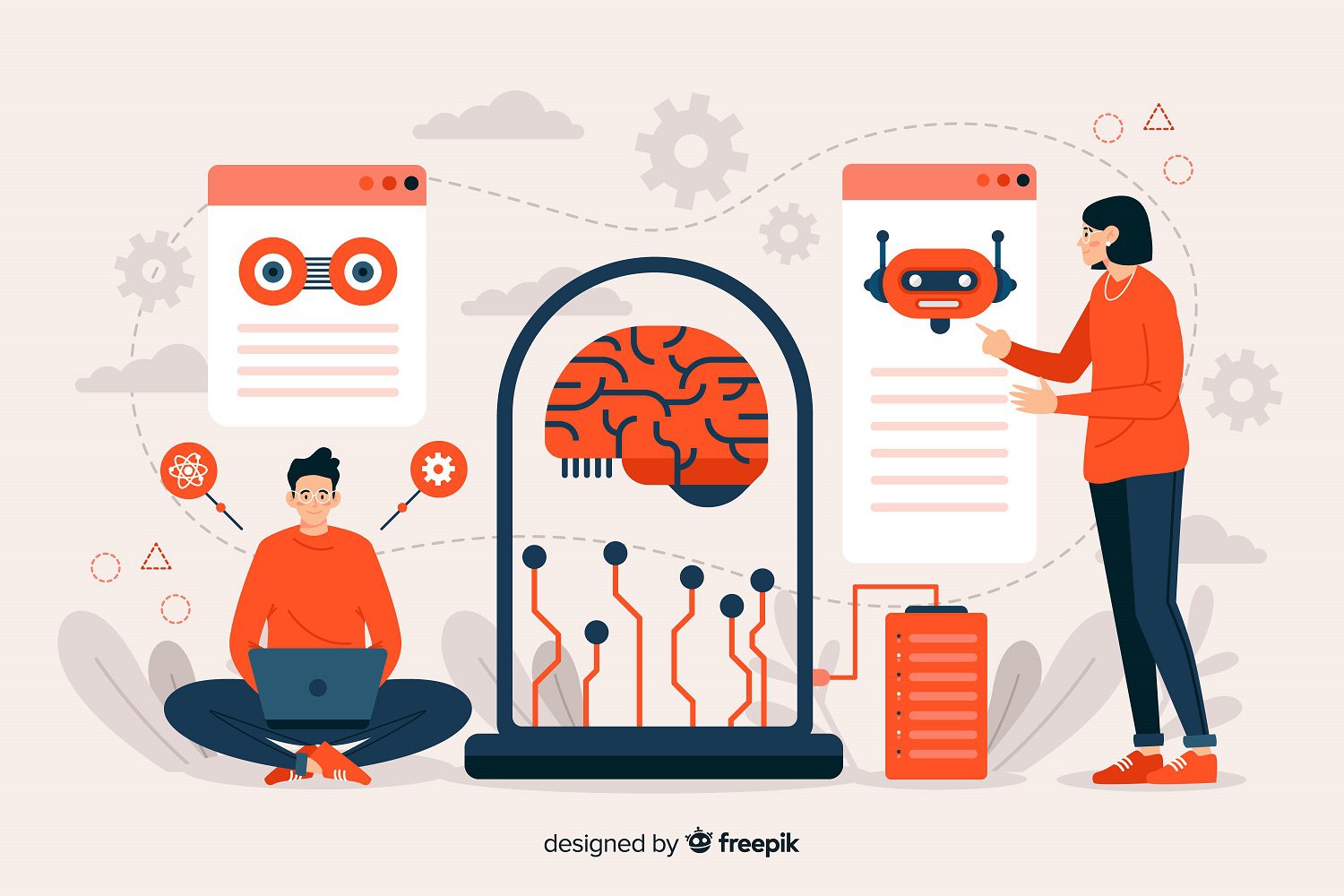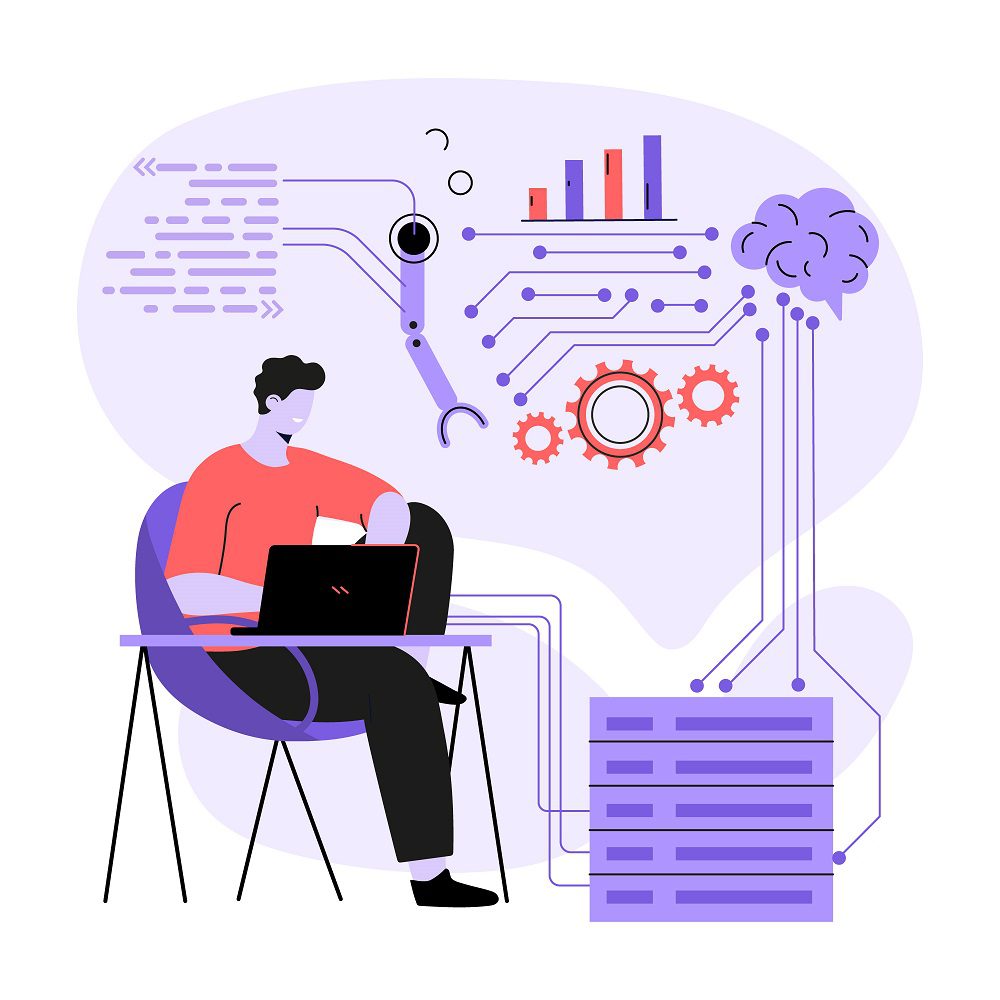How Do Artificial Intelligence (AI) Functions in Reality?

Introduction:
More front-page stories regarding artificial intelligence appear daily. Artificial intelligence, or AI, is the field of computer science that enables robots to learn from their experiences and perform tasks akin to those performed by humans.
Opinions on artificial intelligence’s current and potential uses, or worse, consequences, are extremely divergent, swinging between utopian and dystopian. Without the right anchors, our thoughts frequently stray into Hollywood-created waters, filled with robot revolutions, autonomous vehicles, and scant knowledge of how AI operates.
This is because AI describes various technologies that allow robots to learn in an “intelligent” manner. In this article, Strivemidz examines how people use AI in various industries, discusses its development problems, and provides suggestions for maximizing its benefits while upholding important human values.
Artificial intelligence: What Is It?
The objective of artificial intelligence (AI), a large subject of computer science, is to create intelligent machines that can do activities that typically require human intelligence. Even though the interdisciplinary science of artificial intelligence (AI) has many diverse schools of thought, developments in machine learning and deep learning are ushering in a new way of thinking in virtually every sector of the IT industry.
Thanks to artificial intelligence, machines can simulate and even improve the human mind. Since self-driving cars first appeared and smart assistants like Siri and Alexa have proliferated, AI is becoming more and more pervasive in daily life. Because of this, many IT businesses from many industries are investing in artificial intelligence technologies.
What uses does artificial intelligence have?
In common misconceptions, AI is portrayed as living on an island with robots and autonomous vehicles. However, this method needs to pay attention to the processing of the enormous amounts of data generated daily, which is artificial intelligence’s primary practical application. Insight gathering and task automation occur at a tempo and scale that would be unthinkable without the strategic application of AI to specific activities.
AI systems intelligently comb through the mounds of data that people have generated, reading both text and images to find patterns in complex material and then act on what they have learned.
AI’s Potential:
Putting Artificial Intelligence work is a difficult and expensive endeavour when considering the computing costs and the technical data infrastructure that supports artificial intelligence. Fortunately, there have been significant technological advances, as demonstrated by Moore’s Law, which claims that the price of computers is cut in half. Additionally, every two years, the transistor counts on a double microchip.
According to various experts, Moore’s Law has significantly influenced current AI approaches, and deep learning wouldn’t be financially possible until the 2020s without it. A recent study found that AI innovation has exceeded Moore’s Law, which doubles nearly every six months as opposed to every two years.
Such an argument holds that artificial intelligence has considerably advanced various industries over the past few years. There is a good chance that the influence will grow during the ensuing decades.
What fundamental aspects of artificial intelligence are there?
Modern technology allows computer systems to interpret human language, gain knowledge through experience, and make predictions. The secret to encouraging conversation on this technology’s practical uses is comprehending AI jargon.
● Machine Learning
With machine learning, also known as ML, a branch of AI, computer systems may now automatically learn from their experiences and get better over time without having to be explicitly programmed. Creating AI algorithms capable of data analysis and prediction is the main goal of ML. Machine learning is being utilized in the healthcare, pharma, and life sciences sectors to speed up drug development as well as diagnose diseases and choose the best course of action for your Uber ride.
● Deep Learning
Deep learning, a branch of machine learning, employs artificial neural networks that learn by studying data. To emulate biological neural networks seen in the human brain, artificial neural networks were created.
To detect the image of a face from a mosaic of tiles, for instance, multiple layers of artificial neural networks collaborate to decide a single output from numerous inputs. The activities that the robots perform are reinforced positively and negatively as they learn, and to advance, this process must be continually processed and reinforced. Speech recognition is another application of deep learning that enables smartphone voice assistants to comprehend inquiries like, “Hey Siri, what’s the weather today?”
● Neural Network
Deep learning is enabled via neural networks. As was already mentioned, neural networks are computer programs that model the neuronal connections found in the human brain. A perceptron is a synthetic equivalent of a human neuron. Bundles of neurons in the human brain create artificial neural networks like how stacks of perceptrons do so in computer systems. By analyzing training instances, neural networks can learn. The finest illustrations come from big data sets, such as a collection of 1,000 dog pictures. The computer can create a single output that responds to the query, “Is the image a dog or not?” by analyzing the numerous photos (inputs).
This method aims to uncover relationships between data points and give previously meaningless data a purpose. The system is trained to recognize the object correctly using a variety of learning techniques, such as positive reinforcement.
● Cognitive Computing
Another crucial element of AI is cognitive computing. Its objective is to emulate and enhance human-machine interaction. Cognitive computing tries to simulate the human mind in a computer model by understanding spoken language and the relevance of visual clues. Artificial General Intelligence and cognitive computing work together to give robots human-like behavior and information-processing skills.
● Natural Language Processing
Computers can comprehend, recognize, and even produce human language and voice thanks to a process known as natural language processing, or NLP. As a result of NLP, we are able to seamlessly integrate our daily technology with the human language we use in context by training robots to understand it. In the real world, NLP tools like Skype Translator are used to improve communication by instantly translating speech into a variety of languages.
● Computer Vision
To analyze the content of an image, including the graphs, tables, and images found in PDF documents as well as other text and video, computer vision employs deep learning and pattern recognition, such as facial recognition. Because to the discipline of artificial intelligence known as computer vision, computers can now identify, process, and interpret visual data. Uses of this technology have already begun to change industries like healthcare and research & development. It is feasible to diagnose patients more quickly by using computer vision and machine learning to analyze x-ray scans of patients.
Artificial Intelligence: The Four Forms & future of AI
Four types of AI can be categorized based on the types and levels of tasks a system can perform.
● Reactive Machines
A reactive computer, as its name implies, can only use its intellect to see and react to the environment in front of it, and it does so by the most fundamental AI principles. A reactive machine lacks memory, which prevents it from drawing on the past to inform judgements made today.
Because they can only experience the world instantly, reactive machines can only carry out a tiny number of extremely specialized activities. Yet, deliberately restricting a reactive machine’s worldview makes it more reliable and trustworthy because it will react consistently to the same stimuli. Reactive machine AI can achieve a level of complexity and offer dependability when designed to carry out recurring activities, even while its scope is constrained and it is difficult to modify.
● Limited Memory
When gathering information and assessing options, limited memory AI can store past facts and forecasts, effectively looking backwards for hints on what might happen ahead. Reactive machines lack the complexity of limited memory AI, which offers more opportunities. Limited memory AI is created when a model is continuously educated to understand and utilise new data or when an environment is offered for AI where models may be continuously trained and updated.
● Theory of Mind
The theory of mind is purely hypothetical. To develop this next stage of AI, we still need the technological and scientific advancements required.
The concept is based on the psychological insight that other living things’ thoughts and feelings have an impact on one’s actions. This suggests that artificial intelligence (AI) systems may comprehend how people, animals, and other machines feel and make decisions through self-reflection and willpower and would use that understanding to make their own decisions. Although AI with limited memory can accomplish a lot, it isn’t as intelligent as humans. As an example, because it won’t commit the same mistakes as a human driver, a self-driving car may perform better than one most of the time. An AI vehicle with basic, limited memory wouldn’t be able to slow down while passing that neighbor’s driveway, but if you, as the driver, knew that your neighbor’s child frequently plays along the street after school, you’ll know instinctively to do so.
● Self-Awareness
The AI point of singularity is the stage after the theory of mind when artificial intelligence becomes self-aware. Once that stage is achieved, it is predicted that AI machines will no longer be under our control since they will be able to feel their own emotions in addition to those of others. The ability of human researchers to understand the fundamentals of consciousness and then figure out how to replicate it in machines is a prerequisite for AI self-awareness.
Why Choose Strivemindz for AI App Development?
Strivemindz is regarded as one of the top firms for developing machine learning and artificial intelligence in the tech sector. Our business has more than ten years of experience developing solutions that satisfy AI market demands, strengthen brands, and promote growth. You may get access to the best IT solutions with Strivemindz. Our cutting-edge development of AI services assists in quickly solving challenging business issues and automating corporate processes. By assisting in the automation of iterative tasks, our team of specialists decreases the amount of time that complex procedures are not in use and speeds up decision-making. Our AI solutions assist in integrating automated solutions for fresh business prospects.
Conclusion
As we have been taught, artificial intelligence refers to a variety of technologies. A thorough explanation is needed for each of these technologies. It’s challenging to stay current with and comprehend how these technologies differ from one another.
Although AI systems are still in their infancy, they will significantly affect society as a whole in the years to come. It affects how policy concerns are handled, moral disagreements are resolved, legal constraints are met, and how much transparency is demanded of Artificial Intelligence and data analytic solutions.
To better understand how these activities are conducted, it’s important to better understand how they will affect the general public soon and in the foreseeable future. AI can transform society and become the most significant invention in human history.
Frequently Asked Questions
Can Human Intelligence Be Replaced by Artificial Intelligence?
Although it’s unlikely artificial intelligence will revolutionize the roles that people play in society. In most fields, AI is now viewed as a supplement to the intelligence of humans rather than a replacement.
Why is artificial intelligence necessary, and what can it accomplish?
A number of advantages are expected to accompany the future of artificial intelligence. This includes making it possible for machines to perform menial or repetitive work, supporting us in our daily activities, and revolutionizing the manufacturing, transportation, and healthcare industries.
How do neural networks work?
The organic neural networks in human brains served as the inspiration for computer systems known as neural networks. They are made up of artificial neurons, which are units or nodes that enable applications for machine learning & other forms of artificial intelligence.
How does machine learning work? Is it identical to AI?
A component of artificial intelligence called machine learning is based on the idea of giving machines access to data that they may utilize the ability to learn and grow on their own.
What is the role of an AI consultant?
Utilizing AI and analytical algorithms, our team of AI consultants at Strivemindz assists you in resolving challenging business issues. To carry out tasks, we employ organized decision-making processes. Our AI consulting team will support you at every stage of the execution of your AI project, from creating an AI strategy roadmap to creating a scalable AI solution and deploying production-grade AI.
The duration of the planning, scoping, and implementation of an AI project is how long?
Each company’s commercial objectives have an impact on the feasibility of projects and their complexity. The requirements of the client will determine how long it takes to scope, plan, and execute a project. Our AI software development team delivers a precise project timeline with the deliverables to be produced within a certain time frame before starting any project.



